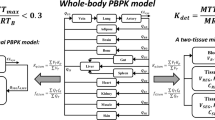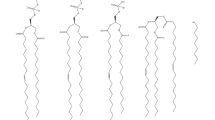Abstract
In this paper we present three physiologically based pharmacokinetic (PBPK) models for the systemic transport of trichloroethylene (TCE), with a focus on the adipose, or fat tissue. TCE is a widespread environmental contaminant, and has been shown to produce toxic effects in both animals and humans. A key characteristic of TCE is its tendency to accumulate in fat tissue, which has a major impact on the overall systemic disposition of TCE.
Here we use PBPK models to predict the dynamics of TCE in the various tissues and organs, including the adipose tissue. The first model utilizes the standard ‘perfusion-limited’ compartmental model for the fat tissue, while the second model uses a ‘diffusion-limited’ model to describe the transport through the adipose tissue. Both of these ODE models are based on ‘well-mixed’ and rapid equilibrium assumptions, and do not take into account the specific and largely heterogeneous physiology of adipose tissue.
The third model we discuss is a PBPK hybrid model with an axial-dispersion type model for the adipose tissue. This PDE-based model is designed to capture key physiological heterogeneities of fat tissue, including widely varying fat cell sizes, lipid distribution, and blood flow properties. Model simulations demonstrate that this model may be well-suited to predict the experimental behavior of TCE in adipose tissue using parameter estimation techniques.
Similar content being viewed by others
References
Abbas, R. and J. Fisher (1997). A physiologically based pharmacokinetic model for trichloroethylene and its metabolites, chloral hydrate, trichloroacetate, dichloroacetate, trichloroethanol, and trichloroethanol glucuronide in B6C3F1 mice. Toxicol. Appl. Pharmacol. 147, 15–30.
Ahmad, N., W. Harsas, R. S. Marolt, M. Morton and J. K. Pollack (1988). Total DDT and dieldrin content of human adipose-tissue. Bull. Environ. Contam. Toxicol. 41, 802–808.
Banks, H. T. (2001). Remarks on uncertainty of assessment and management in modeling and computation. Tech. Rep. CRSC-TR98-39, Center for Research in Scientific Computation, North Carolina State University, November 1998; Math. Comput. Modelling 33, 39–47.
Banks, H. T. and K. L. Bihari (2001). Modeling and estimating uncertainty in parameter estimation. Tech. Rep. CRSC-TR99-40, Center for Research in Scientific Computation, North Carolina State University, December 1999; Inverse Probl. 17, 1–17.
Banks, H. T., C. J. Musante and J. K. Raye (2001). Predictions for a distributed parameter model describing the hepatic processing of 2,3,7,8-TCDD. Tech. Rep. CRSC-TR98-38, Center for Research in Scientific Computation, North Carolina State University, November 1998; Math. Comput. Modelling 33, 49–64.
Banks, H. T., C. J. Musante and H. T. Tran (1998). A dispersion model for the hepatic uptake and elimination of 2,3,7,8-tetrachlorodibenzo-p-dioxin. Math. Comput. Modelling 28, 9–29.
Barton, H. A. and H. J. Clewell III (2000). Evaluating noncancer effects of trichloroethylene: dosimetry, mode of action, and risk assessment. Environ. Health Perspect. 108(Suppl. 2), 323–334.
Bergman, K. (1983). Application and results of whole-body autoradiography in distribution studies of organic solvents. Crit. Rev. Toxicol. 12, 59–118.
Blanchette-Mackie, E. J. and R. O. Scow (1982). Continuity of intracellular channels with extracellular space in adipose tissue and liver: demonstrated with tannic acid and lanthanum. Anat. Rec. 203, 205–219.
Blanchette-Mackie, E. J. and R. O. Scow (1981a). Lipolysis and lamellar structures in white adipose tissue of young rats: lipid movement in membranes. J. Ultrastructure Res. 77, 295–318.
Blanchette-Mackie, E. J. and R. O. Scow (1981b). Membrane continuities within cells and intercellular contacts in white adipose tissue of young rats. J. Ultrastructure Res. 77, 277–294.
Brauch, H., G. Weirich, M. A. Hornauer, S. Storkel, T. Wohl and T. Bruning (1999). Trichloroethylene exposure and specific somatic mutations in patients with renal cell carcinoma. J. Nat. Cancer Inst. 91, 854–861.
Bruckner, J. V., B. D. Davis and J. N. Blancato (1989). Metabolism, toxicity, and carcinogenicity of trichloroethylene. Crit. Rev. Toxicol. 20, 31–50.
Bull, R. J. (2000). Mode of action of liver tumor induction by trichloroethylene and its metabolites, trichloroacetate and dichloroacetate. Environ. Health Perspect. 108(Suppl.2), 241–260.
Bush, M. L., C. B. Frederick, J. S. Kimbell and J. S. Ultman (1998). A CFD-PBPK hybrid model for simulating gas and vapor uptake in the rat nose. Toxicol. Appl. Pharmacol. 150, 133–145.
Byard, J. L. (1987). The toxicological significance of 2,3,7,8-tetrachlorodibenzo-p-dioxin and related compounds in adipose tissue. J. Toxicol. Environ. Health 22, 381–403.
Courant, R. and D. Hilbert (1989). Methods of Mathematical Physics, Vol. I, New York: John Wiley & Sons.
Crandall, D. and M. DiGirolamo (1990). Hemodynamic and metabolic correlates in adipose tissue: Pathophysiologic considerations. FASEB 4, 141–147.
Crandall, D., G. J. Hausman and J. G. Kral (1997). A review of the microcirculation of adipose tissue: anatomic, metabolic, and angiogenic perspectives. Microcirculation 4, 211–232.
Davidson, I. W. F. and R. P. Beliles (1991). Consideration of the target organ toxicity of trichloroethylene in terms of metabolite toxicity and pharmacokinetics. Drug Metab. Rev. 23, 493–599.
Di Francesco, C. and M. H. Bickel (1985). Uptake in vitro of lipophilic model compounds into adipose tissue preparations and lipids. Biochem. Pharmacol. 34, 3683–3688.
Evans, M. V., W. K. Boyes, P. J. Bushnell, J. H. Raymer and J. E. Simmons (1999). A Physiologically Based Pharmacokinetic Model for Trichloroethylene (TCE) in Long-Evans Rats. Preprint.
Fisher, J. W., M. L. Gargas, B. C. Allen and M. E. Andersen (1991). Physiologically based pharmacokinetic modeling with trichloroethylene and its metabolite, trichloroacetic acid, in the rat and mouse. Toxicol. Appl. Pharmacol. 109, 183–195.
Fisher, J. W., D. Mahle and R. Abbas (1998). A human physiologically based pharmacokinetic model for trichloroethylene and its metabolites, trichloroacetic acid and free trichloroethanol. Toxicol. Appl. Pharmacol. 152, 339–359.
Fournier, R. L. (1999). Basic Transport Phenomena in Biomedical Engineering, Philadelphia: Taylor & Francis.
Fung, Y. C. (1981). Biomechanics: Mechanical Properties of Living Tissues, New York: Springer-Verlag.
Goeptar, A. R., J. N. M. Commandeur, B. van Ommen, P. J. van Bladeren and N. P. E. Vermeulen (1995). Metabolism and kinetics of trichloroethylene in relation to toxicity and carcinogenicity. Relevance of the mercapturic acid pathway. Chem. Res. Toxicol. 8, 3–21.
Green, T. (2000). Pulmonary toxicity and carcinogenicity of trichloroethylene: species differences and modes of action. Environ. Health Perspect. 108(Suppl. 2), 261–264.
Greenberg, M. S., G. A. Burton and J. W. Fisher (1999). Physiologically based pharmacokinetic modeling of inhaled trichloroethylene and its oxidative metabolites in B6C3F1 mice. Toxicol. Appl. Pharmacol. 154, 264–278.
Guyton, A. C. (1991). Textbook of Medical Physiology, Philadelphia: W.B. Saunders Company.
Hausman, G. J. (1985). The comparative anatomy of adipose tissue, in New Perspectives in Adipose Tissue: Structure, Function and Development, A. Cryer and R. L. R. Van (Eds), London, U.K.: Butterworths.
Lash, L. H., J. W. Fisher, J. C. Lipscomb and J. C. Parker (2000a). Metabolism of trichloroethylene. Environ. Health Perspect. 108(Suppl. 2), 177–200.
Lash, L. H., J. C. Parker and C. S. Scott (2000b). Modes of action of trichloroethylene for kidney tumorigenesis. Environ. Health Perspect. 108(Suppl. 2), 225–240.
Levenspiel, O. (1999). Chemical Reaction Engineering, 3rd edn, New York: John Wiley and Sons.
Lordo, R. A., K. T. Dinh and J. G. Schwemberger (1996). Semivolatile organic compounds in adipose tissue: estimated averages for the US population and selected subpopulations. Am. J. Public Health 86, 1253–1259.
MacQueen, H. A., V. Waights and C. M. Pond (1999). Vascularization in adipose depots surrounding immune-stimulated lymph nodes. J. Anat. 194, 33–38.
Medinsky, M. A. and C. D. Klaassen (1996). Toxicokinetics, in Casarett and Doull’s Toxicology: The Basic Science of Poisons, 5th edn, C. D. Klaassen (Ed.), New York: McGraw-Hill, Health Professions Division.
Minder, S., W. A. Daniel, J. Clausen and M. H. Bickel (1994). Adipose-tissue storage of drugs as a function of binding competition—in vitro studies with distribution dialysis. J. Pharm. Pharmacol. 46, 313–315.
Pastino, G. M., W. Y. Yap and M. Carroquino (2000). Human variability and susceptibility to trichloroethylene. Environ. Health Perspect. 108(Suppl. 2), 201–215.
Roberts, M. S. and M. Rowland (1986). A dispersion model of hepatic elimination: 1. Formulation of the model and bolus considerations. J. Pharmacokinet. Biopharm. 14, 227–260.
Rosell, S. and E. Belfrage (1979). Blood circulation in adipose tissue. Physiol. Rev. 59, 1078–1104.
Roy, A., C. P. Weisel, P. J. Lioy and P. G. Georgopoulos (1996). A distributed parameter physiologically-based pharmacokinetic model for dermal and inhalation exposure to volatile organic compounds. Risk Anal. 16, 147–160.
Saillenfait, A. M., I. Langonne and J. P. Sabate (1995). Developmental toxicity of trichloroethylene, tetrachloroethylene and four of their metabolites in rat whole embryo culture. Arch. Toxicol. 70, 71–82.
Scott, C. S. and V. J. Cogliano (2000). Trichloroethylene health risks-state of the science. Environ. Health Perspect. 108(Suppl. 2), 159–160.
Scow, R. O., E. J. Blanchette-Mackie and L. C. Smith (1980). Transport of lipid across capillary endothelium. Federation Proc. 39, 2610–2617.
Simon, T. M., F. Reitich, M. R. Jolly, K. Ito and H. T. Banks (2001). The effective magnetic properties of magnetorheological fluids. Math. Comput. Modelling 33, 273–284.
Simon, T. M., F. Reitich, M. R. Jolly, K. Ito and H. T. Banks (1999). Estimation of the effective permeability in magnetorheological fluids. Tech. Rep. CRSC-TR98-35, Center for Research in Scientific Computation, North Carolina State University; J. Intell. Mater. Syst. Struct. 10, 872–879.
Slavin, B. G. (1985). The morphology of adipose tissue, in New Perspectives in Adipose Tissue: Structure, Function and Development, A. Cryer and R. L. R. Van (Eds), London, U.K.: Butterworths.
Stenner, R. D., J. L. Merdink, J. W. Fisher and R. J. Bull (1998). Physiologically-based pharmacokinetic models for trichloroethylene considering enterohepatic recirculation of major metabolites. Risk Anal. 18, 261–269.
Telford, I. R. and C. F. Bridgman (1995). Introduction to Functional Histology, New York: HarperCollins College Publishers.
United Nations Environment Programme, International Labour Organisation and World Health Organization (1985). Trichloroethylene, Geneva: World Health Organization.
West, D. B., W. A. Prinz, A. A. Francendese and M. R. C. Greenwood (1987). Adipocyte blood flow is decreased in obese Zucker rats. Am. J. Physiol. 253, R228–R233.
Author information
Authors and Affiliations
Rights and permissions
About this article
Cite this article
Albanese, R.A., Banks, H.T., Evans, M.V. et al. Physiologically based pharmacokinetic models for the transport of trichloroethylene in adipose tissue. Bull. Math. Biol. 64, 97–131 (2002). https://doi.org/10.1006/bulm.2001.0268
Received:
Accepted:
Issue Date:
DOI: https://doi.org/10.1006/bulm.2001.0268




